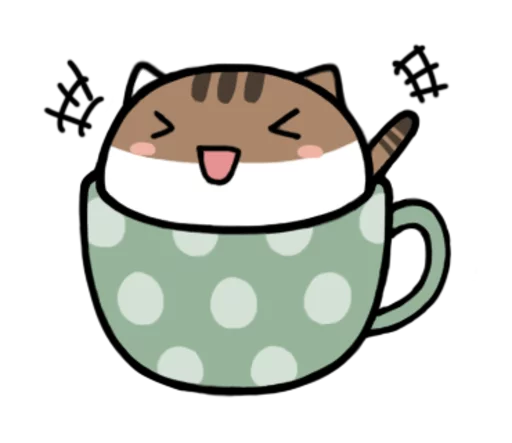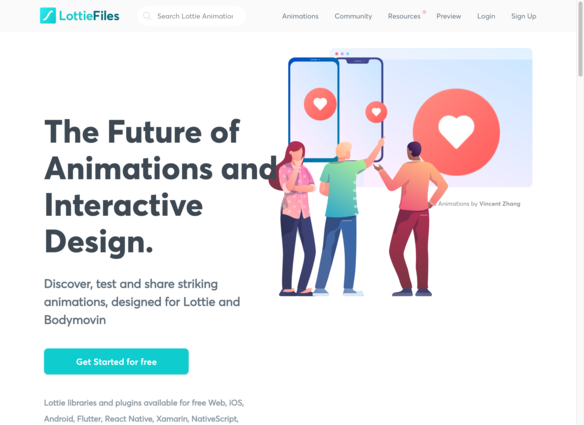This morning, Telegram added support for animated stickers:
Animated Stickers Done RightWe launched stickers back in January 2015. Since then, the Telegram sticker format has been adopted by other apps to reach a total of 2 billion people. Today we're introducing a new format for animated stickers.https://telegram.org/blog/animated-stickers
Animated stickers can already be found in other messaging apps like WeChat or Line, but Telegram's annoucement was not claiming that they were the first to introduce animated stickers—instead, it's putting forward a new file format for animated stickers.
A closer look
Interesting, let's download the example sticker sent by the app and take a closer look:
First off, how much space does it take up really?
$ ls -lh animated-sticker.tgs
-rw-------@ 1 yijiayu staff 15K Jul 7 20:01 animated-sticker.tgs
Wow, only 15 KB? It's actually even smaller than this static cat in a cup sticker from the CafeNyanbyTikelku sticker pack, which weighs in at 19 KB:

$ ls -lh sticker.webp
-rw-------@ 1 yijiayu staff 19K Jul 7 20:24 sticker.webp
Is TGS actually some existing format in disguise?
$ file animated-sticker.tgs
animated-sticker.tgs: gzip compressed data, max compression, from Unix, original size 109754
Oh, it's GZIP compressed? What will we get if we uncompress it?
$ gzip -dc animated-sticker.tgs > animated-sticker
$ file animated-sticker
animated-sticker: ASCII text, with very long lines, with no line terminators
It's actually a text file! What does it contain?
$ head -c 200 animated-sticker
{"tgs":1,"v":"5.5.2","fr":60,"ip":0,"op":180,"w":512,"h":512,"nm":"C-07","ddd":0,"assets":[],"comps":[],"layers":[{"ddd":0,"ind":1,"ty":3,"nm":"master","sr":1,"ks":{"o":{"a":0,"k":0},"r":{"a":0,"k":0}
JSON!!!
So what exactly are TGS files?
Let's go back to the release annoucement for a moment:
Telegram engineers experimented with vector graphics, packaging methods and forbidden magic to create the Lottie-based .TGS format, in which each sticker takes up about 20-30 Kilobytes – six times smaller than the average photo.
Lottie
When I first read the release announcement, I thought Lottie was some kind of new compression algorithm like Brotli or AV1. Some quick research reveals that it's actually an Airbnb-developed library which renders Adobe After Effects animations exported in JSON format:
LottieEasily add high-quality animation to any native app. Lottie is an iOS, Android, and React Native library that renders After Effects animations in real time, allowing apps to use animations as easily as they use static images.https://airbnb.design/lottie/
So that's why the TGS file contained JSON data!
Thoughts about Telegram animated stickers
Higher barriers to entry
When Telegram introduced custom sticker sets, the ease of creating your own sticker pack was a big deal. Anyone could just strike up a conversation with the @stickers bot, send it a photo and you would get a link to your very own sticker pack.
However, at the moment there's a higher barrier to entry for animated stickers—Adobe After Effects itself already costs more than SGD$25 a month, or nearly SGD$300 for a prepaid annual subscription. I think it's unlikely that we'll be creating animated stickers of our classmates, friends or colleagues for fun in the near future.
On the other hand, animated GIFs—which Telegram has supported for a long time—already meet the abovementioned use case, so there's no real need for the average Telegram user to create their own animated stickers anyway.
Less support for open standards
I initially had reservations about Telegram's introduction of its own original file format (obligatory XKCD about standards). In the past, Telegram has also drawn criticism for its creation of its own cryptographic protocol which it uses to secure its messages. Given that static Telegram stickers are already being served using WebP, an existing image format, I had thought that it would be natural to do the same for animated stickers (it's true that WebP is not as widely adopted itself though).
Encouragingly, Airbnb's Lottie, which Telegram's animated stickers are based on, does seem to have some momentum. At least one site, LottieFiles, touts itself as “The Future of Animations and Interactive Design”. Perhaps in the future, tooling to make working with TGS files easier will exist. Perhaps even interoperability with the existing Lottie ecosystem will be possible.

Conclusion
As usual, I'm not actually going to make any concrete statements, but in my opinion, animated stickers are pretty gimmicky right now. Nevertheless, Telegram is undoubtedly an influential platform on its own, and is bullish on the future of animated stickers themselves:
Like its static predecessor, the Telegram animated sticker format is likely to become the new industry standard in messaging.
PS. Amusingly, the animations on the release announcement are just MP4 videos, but admittedly they're announcing a new feature for their own platform, not the web.